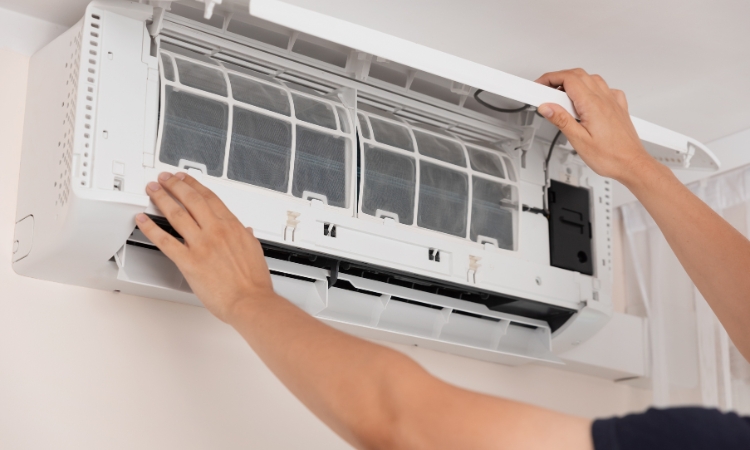Air Conditioner Condensation: What Causes It?
One of the natural by-products of air conditioning is condensation. Eliminating heat and moisture from the air is how an air conditioner operates. Your unit’s evaporator coil gathers this moisture, which then condenses into water. A condensate drain pipe is the ideal means of discharging the water. However, issues may occur if this mechanism gets blocked or if other circumstances interfere with the AC’s regular operation. The following are some typical reasons for high air conditioner condensation:
- Clogged Drain Lines: Dirt, dust, and algae can build up in the drain line over time, resulting in obstructions that hinder adequate drainage.
- Improper Installation: Water may pool or leak as a result of improperly installed systems that do not drain water effectively.
- Low Refrigerant Levels: The evaporator coil may freeze if the refrigerant levels are too low. Water may flood as a result of the ice melting.
- Unclean Air Filters: When an air filter becomes clogged, it can block airflow, which can cause the evaporator coil to freeze and produce too much water when it thaws.
- Damaged Drain Pan: As the drain pan rusts or cracks, leaks may occur, potentially resulting in water damage.
- Excess Humidity: If your air conditioner isn’t dehumidifying well, high interior humidity levels may cause extra condensation to collect on the evaporator coil.
The Importance of Dealing with Air Conditioning Condensation:
Ignoring condensation concerns can result in several issues, such as:
- Water Damage: Your walls, ceilings, floors, and furnishings may sustain damage from excessive condensation. If ignored, it may even result in structural problems.
- Mold Development: Mold thrives in moist conditions. Condensation can provide the ideal environment for mould growth, endangering human health and necessitating expensive clean-up.
- Decreased Aircon Efficiency: An air conditioner that is having condensation issues may not operate as effectively, which could result in greater energy costs and poorer cooling capabilities.
How to Avoid Or Fix Condensation Issues in Air Conditioners?
It’s critical to take care of condensation problems right away if you currently have them to prevent more harm. The following are some typical solutions for various condensation issues:
1. Frequent Upkeep:
The first line of defence against condensation problems is preventative maintenance. A competent HVAC technician performing routine tune-ups will assist in spotting possible issues before they become more serious. Typical maintenance duties consist of:
- To avoid moisture accumulation, clean the evaporator coils.
- Verifying the system’s efficiency by checking the refrigerant levels.
- Examining and clearing the drain line of any obstructions or clogs.
- Check that the air filters are clean and provide adequate ventilation.
2. Set Up a Slope for the Drain Line:
The condensate drain line should be built with a small slope to guarantee that water drains correctly. Water may pool instead of draining away if the line is not properly slanted. To avoid backup, a skilled technician can correctly angle the drain pipe.
3. Put A Dehumidifier To Use:
Your air conditioner may have trouble effectively removing moisture if you reside in a humid area, which could result in condensation issues. The amount of condensation that forms inside the air conditioner can be decreased by installing a dehumidifier, which can assist in lowering interior humidity levels. Dehumidifiers are especially helpful in places where the humidity regularly rises above 60%.
4. Regularly Clean Or Replace Air Filters:
One of the primary reasons for reduced airflow, which can result in ice accumulation on the evaporator coil, is a dirty air filter. The system’s capacity to drain water may be overloaded when the ice melts. Maintaining a smooth airflow and avoiding needless condensation can be achieved by cleaning or replacing the air filter every one to three months.
5. Examine The Drain Pan:
The most frequent reason for air conditioner water leaks is a plugged condensate drain pipe. Periodically check the drain pan for corrosion, cracks, or rust. There will be water leakage onto the floor if the drain pan is corroded or damaged. Waterproof sealant can be used to temporarily fix minor cracks, but to guarantee long-term dependability, it is recommended to replace the drain pan. Leaks could result from the pan’s improper collection and drainage of water if it is compromised. The drain pan should be replaced right away if you see any damage to it. To remove the obstruction:
- First, clear the drain line.
- Switch off the air conditioner: Before trying any repairs, make sure the device is turned off.
- Find the drain line: The pipe that connects the indoor unit to the exterior of your house is often made of PVC.
- Employ a dry or wet vacuum: To remove any debris, dirt, or algae that might be obstructing the drain line, attach the vacuum to the end of the line.
- Clean the line: To avoid clogs in the future, flush the line with a vinegar and water mixture after it is clear.
6. Refill The Levels Of Refrigerant:
As the evaporator coil freezes due to low refrigerant levels, water may flow out as the ice melts. Call a qualified technician to check and replenish the refrigerant levels in your air conditioner if you think low refrigerant is the cause.
7. Enhance Airflow:
To assist lower humidity levels, make sure your house or place of business has enough airflow. An energy recovery ventilator (ERV), fans, or window openings can all help increase circulation and keep too much moisture from building up indoors.


